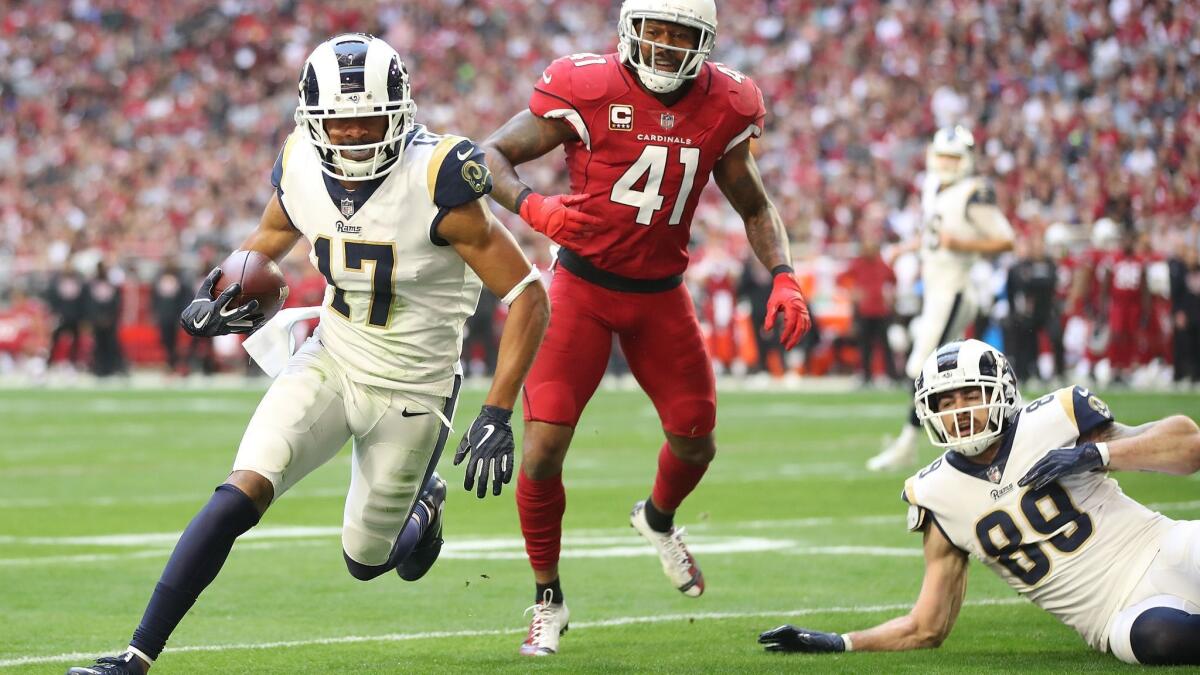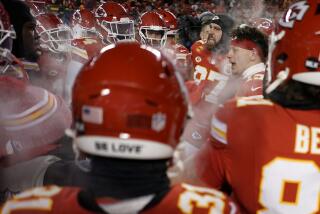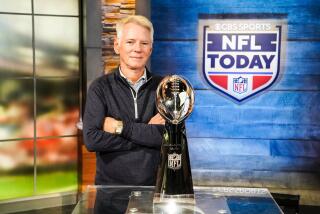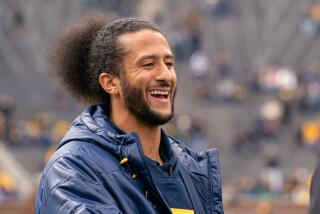Perspective: How does the NFL keep ratings up despite on- and off-field issues? Like the top players, it moves quickly

For much of the 2018 NFL season, the key word has been speed.
Speed in the passing game, as personified by the ridiculously entertaining, 54-51 track meet between the L.A. Rams and the Kansas City Chiefs in mid-November that signaled a potential changing of the guard at the top of the league. Speed in the running game as shown by electric New York Giants rookie Saquon Barkley, who made a last place team suddenly watchable every time he touched the ball.
And, most crucially, speed through a news cycle, which allowed the league to transcend the on- and off-field controversies that headed into the season threatened to upend football’s decades-long run of televised dominance.
After a rough start to the season, NFL ratings have rebounded to where the games remain a reliable hit for the networks. ESPN has been crowing about an 8% jump in Monday Night Football viewership over last year. Sunday Night Football, the NFL’s prime time counterpart on NBC, is up by 6% to regularly top the ratings charts each week. Suddenly, a league that only a few months ago was targeted by presidential tweets with boasts about ratings being “WAY DOWN” is enjoying business as usual.
Should credit go to, as Trump referenced in September, a settlement to the protests about racial inequality and police violence headed by quarterback Colin Kaepernick that began with his dropping to one knee in 2016 during the national anthem before being exiled from the league? Or perhaps the ratings boost is a result of new rules designed to increase player safety, a subject that cast a shadow over the league as star players were regularly sidelined and concussion protocols were instated in an effort to head off the CTE symptoms that cut short the lives of ex-players like San Diego Charger great Junior Seau?
While the NFL would prefer if both were true, the answer is more fuzzy, and is probably more credited to a mix of better message management and, not to be overlooked, a bit of good luck.
Going into the season, there was no indication that the league had any facility with managing the social activism that begun to ripple through the organization. In contrast with the NBA, which has seen its greatest player, LeBron James, engage in critical Twitter exchanges with the president as team owners and coaches either offer support or stay out of the way, the NFL headed into the season with a series of fumbles. In the summer, the league attempted to acquiesce to the political firestorm ignited by the president with a policy demanding all players on the field stand for the anthem. The NFL Players Assn. took issue, which eventually resulted in no formal policy once the games began.
But the answer, ultimately, was found by television — or, more to the point, not found there at all. In August, CBS and ESPN decided they would no longer broadcast the anthem — a “tradition” that only required the players to be on the field for the song beginning in 2009, and even then it wasn’t often televised. Even Fox, the sporting wing of the news network that helped push the president’s views, quit showing the anthem other than games scheduled on Veterans Day and Thanksgiving.
It was a simple, nearly accidental solution — out of sight, out of mind. Whether exhausted by the long, often mischaracterized controversy or recognizing the absence of a broadcast platform, only two of some 1,700 players in the league continued the protest as the season began. It was a lesson both the NFL and its television partners seemed to remember with other unpleasant topics that threatened to disrupt the very lucrative business at hand.
Consider the NFL’s injury issues, which includes its attempts to stem concerns surrounding the concussions that are near-inevitable side-effects of a game built upon collisions between very large, very fast human beings.
The league’s independently compiled injury data released at the end of last season showed a 16% increase in diagnosed concussions in 2017 versus the year before, which resulted in the NFL’s “call to action” to protect players with changes to rules around kickoffs and tackling. Whether such changes were effective remains to be seen, but from a broadcast perspective the injuries are now a less common sight for viewers.
For the second year, the league is using movable blue tents to house on-field medical examinations in an effort to increase player privacy and, as a NFL representative told The Times in 2017, “providing the player and the physician with a distraction-free environment.” As the game quickly resumes, the television audience could be said to enjoy a similar benefit.
Distractions are the enemy of the NFL as an entertainment product, and even as off-field issues have arisen, the league has also aimed to usher them from view as fast as possible. A star on the AFC-leading Kansas City Chiefs, second-year running back Kareem Hunt was caught on video kicking a woman in an incident that for many recalled the 2014 scandal involving former Ravens player Ray Rice, who was filmed punching his then-fiancee in an elevator.
Though the timeline for the NFL’s action against Hunt for what was a nearly year-old video was fuzzy, he was released by his team the same day the video hit the Internet. With no other team moving to sign him to a contract, he remains out of the league.
The NFL was praised for acting quickly, particularly when viewed in contrast with the Rice scandal, but whether Hunt’s past will be remembered next season as teams fill out their rosters remains to be seen. Rice never played professional football again, but Reuben Foster — a 24-year-old linebacker released by the San Francisco 49ers in November after his third domestic violence incident this year — was quickly signed by the Washington Redskins. Some league officials criticized the move, and Foster has yet to play for the team, but for at least one of the NFL’s franchises, the key distinction in evaluating whether violent behavior off the field is a barrier to playing football may be whether cameras were around.
Still, the games go on, regardless of fallout from Hunt, Foster or even Kaepernick, who was subject of a memorable ad campaign for Nike this year but remains out of work even as injuries have led teams to sign other, lesser quarterbacks who haven’t seen action in years. There’s little sustained outcry about any such matters, and with so much in the news outside of the games, who has the mental capacity to sustain outrage over whether one player starts over another?
Not unlike a president once determined to be the league’s adversary, the NFL is benefiting from a news cycle that moves too fast for one threat to capture headlines for long. The formula thus far has been for the NFL to keep moving forward, keep moving fast with focus set firmly on the next game. It’s a philosophy that’s proven to build winning records — both on the field and in the ratings.
Follow me over here @chrisbarton.
ALSO:
More to Read
The complete guide to home viewing
Get Screen Gab for everything about the TV shows and streaming movies everyone’s talking about.
You may occasionally receive promotional content from the Los Angeles Times.







